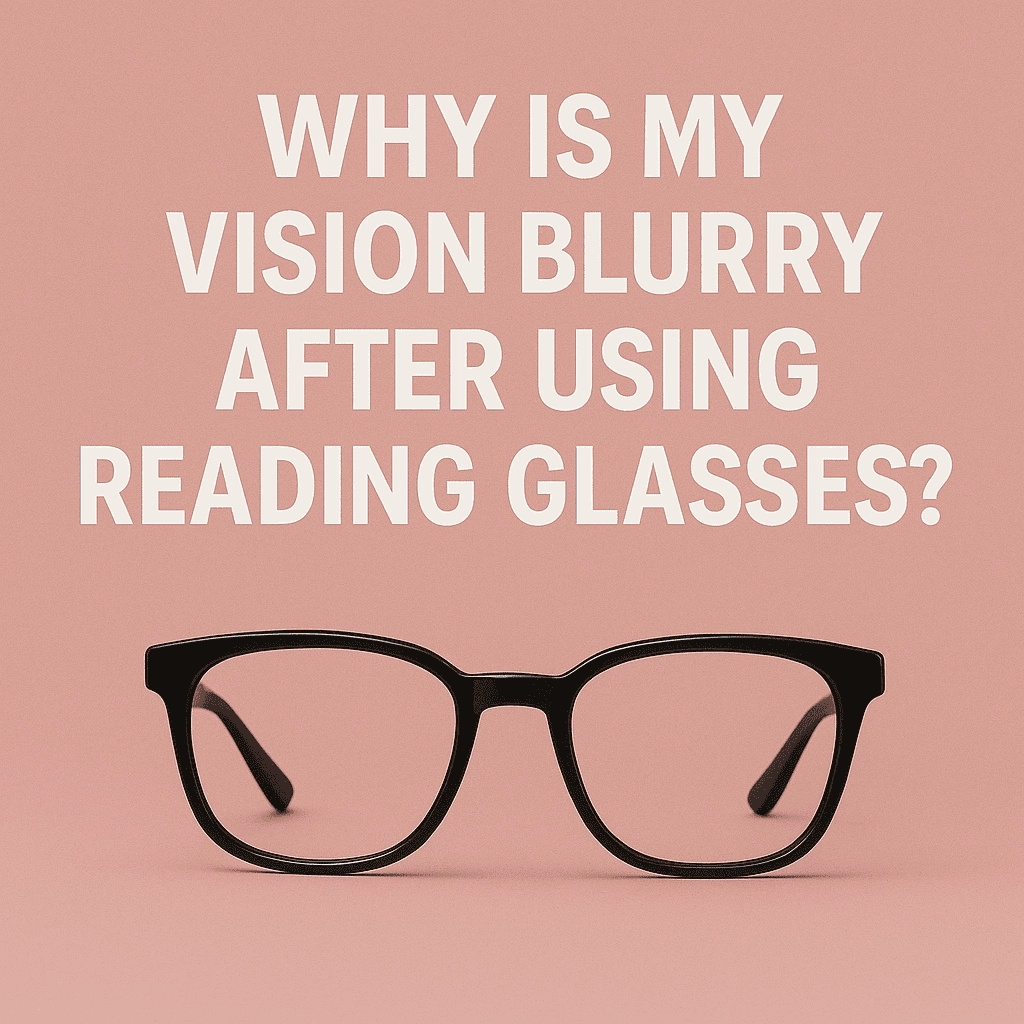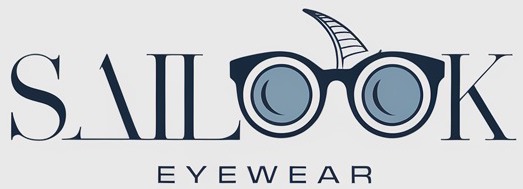If you’ve ever experienced blurry vision after using reading glasses, you’re not alone. Many people, especially those over 40, report temporary blurriness when removing their reading glasses. This issue can be frustrating and confusing, as reading glasses are supposed to improve focus on close-up objects. But why does your vision become blurry once they’re removed? In this article, we’ll explore the reasons behind this phenomenon, the potential causes, and what you can do to address it. By the end, you’ll understand why it happens and what steps to take for clearer vision.

1. Why Does My Vision Get Blurry After Using Reading Glasses?
You might be wondering, why is it that after using reading glasses, my vision becomes blurry once I take them off? To answer this, we must understand how reading glasses function. These glasses are designed to improve near vision, helping people with presbyopia (a condition where the eye’s lens loses flexibility with age) to see text and objects up close. When you remove the glasses, your eyes may struggle to refocus on distant objects. This happens because your eyes have adapted to the magnification provided by the lenses, and without them, your natural ability to focus might temporarily falter.
Here’s the kicker: The blurriness typically occurs due to eye fatigue or a mismatch between the prescription strength and the actual needs of your eyes. If you’ve been using your reading glasses for a prolonged period, your eyes may have become over-reliant on the glasses, leading to temporary visual discomfort when they’re removed. It’s important to recognize that this is usually a temporary condition, and with the right eye care, the symptoms can be reduced.
Additionally, improper lighting or screen use can make the situation worse, causing eye strain that exacerbates blurry vision when you remove your glasses.
| Cause | Description |
|---|---|
| Eye Fatigue | Extended use of reading glasses can cause eye strain. |
| Incorrect Prescription | An outdated or inaccurate prescription can cause blurred vision. |
| Lighting Issues | Poor lighting can strain your eyes while using reading glasses. |
2. What Are the Causes of Blurry Vision After Using Reading Glasses?
Let’s dig into the various reasons why blurry vision happens after using reading glasses. Several factors can contribute to this issue, and understanding them is key to addressing the problem effectively.
First off, eye strain is a major culprit. If you’ve been using reading glasses for an extended period, your eyes may tire from the constant accommodation needed to focus on small text. This strain can cause blurry vision once the glasses are removed. What’s the real story? Over time, this fatigue can cause the eye muscles to struggle with focusing, leading to temporary blurriness.
Another cause of blurry vision is an incorrect prescription. If your reading glasses prescription is outdated or not suited to your current needs, they may not provide the best focus for your eyes. A mismatch between your prescription and your vision needs can lead to blurry vision, especially when switching from near-focus (reading glasses) to far-focus (no glasses).
Lastly, dry eyes can also play a role. Extended use of reading glasses, especially in dry environments, can lead to discomfort and dryness in the eyes. This dryness may cause temporary blurry vision after removing the glasses, as the tear film on your eyes becomes uneven, impacting how light is focused.
| Cause | Impact |
|---|---|
| Eye Strain | Leads to difficulty focusing, resulting in blurry vision. |
| Incorrect Prescription | A mismatch can cause visual discomfort and blurred vision. |
| Dry Eyes | Can lead to uneven tear film and blurry vision after using glasses. |
3. Is Blurry Vision a Sign of a Serious Problem?
Here’s the question on everyone’s mind: When does blurry vision become a serious problem? While occasional blurry vision after using reading glasses is often harmless, there are times when it might indicate an underlying eye condition that requires attention.
What’s the real story? If your blurry vision persists or is accompanied by other symptoms like pain, sudden vision loss, or difficulty seeing at night, it’s important to consult an eye care professional. Conditions such as cataracts, macular degeneration, and glaucoma can cause visual disturbances that may worsen with or without glasses. If you notice a sudden change in vision, don’t ignore it. Early detection and treatment are essential in preventing long-term damage.
In general, if the blurriness only happens after using reading glasses and goes away shortly after, it’s typically due to eye fatigue or a prescription issue. However, if the blurriness is constant, affects your vision at all distances, or worsens over time, an eye exam is strongly recommended.
| Condition | Symptoms |
|---|---|
| Cataracts | Blurry vision, glare, and difficulty seeing at night. |
| Macular Degeneration | Loss of central vision, difficulty reading or recognizing faces. |
| Glaucoma | Gradual vision loss, particularly in peripheral vision. |
4. Could I Be Overusing My Reading Glasses?
What’s the deal with overusing reading glasses? Can it lead to blurry vision? Absolutely. If you rely too heavily on reading glasses, your eyes can become dependent on the correction they provide, making it difficult to focus naturally without them. This is especially true if you’re constantly switching between near and far focus, like when using your phone and looking at distant objects.
Here’s the kicker: Your eye muscles need regular exercise to maintain their ability to focus at different distances. If you spend too much time using reading glasses and don’t give your eyes a break, you may find that your ability to focus without them diminishes, leading to temporary blurry vision. It’s crucial to balance your use of reading glasses with regular breaks, as this can help reduce strain and maintain your eyes’ focusing abilities.
| Solution | Recommendation |
|---|---|
| Regular Breaks | Follow the 20-20-20 rule: Every 20 minutes, look at something 20 feet away for 20 seconds. |
| Exercise Eye Muscles | Perform eye exercises to help strengthen the muscles responsible for focusing. |
5. What Is the Role of Prescription Strength in Blurry Vision?
You might be wondering: How does prescription strength affect blurry vision? Your prescription glasses should provide the necessary correction for your vision, but if the prescription is too strong or too weak, it can result in blurry vision, especially after prolonged use.
What’s the real story? If your reading glasses are not matched to the exact needs of your eyes, they can cause discomfort, including blurry vision after taking them off. If your prescription is too strong, your eyes may struggle to adjust to their natural focus once the glasses are removed. On the other hand, if the prescription is too weak, you may still experience blurry vision while wearing the glasses, and they might not correct your near vision properly.
Getting an eye exam and updating your prescription regularly is crucial in avoiding these issues. The strength of your reading glasses should be tailored to your specific vision needs, and any changes in your eye health should be addressed by a professional.
| Prescription Issue | Solution |
|---|---|
| Overly Strong Prescription | Consider reducing the strength to prevent discomfort. |
| Weak Prescription | Update prescription to ensure it adequately corrects near vision. |
6. Can Eye Health Conditions Cause Blurry Vision After Using Glasses?
Here’s where it gets interesting: Eye health conditions can contribute to blurry vision after using reading glasses. Certain conditions like cataracts, macular degeneration, and astigmatism can cause visual disturbances that might become more noticeable after using reading glasses.
What’s the real story? Cataracts cause the lens in your eye to cloud over, leading to blurry vision that becomes more pronounced with or without glasses. Similarly, macular degeneration affects the central vision, causing difficulty with reading and seeing fine details. Astigmatism, a common refractive error, can cause blurry vision at all distances, even when wearing corrective glasses.
If you have a family history of these conditions or have noticed changes in your vision, it’s important to get regular eye exams to detect these issues early. The right treatment can help manage symptoms and prevent further deterioration of your vision.
| Eye Health Condition | Impact |
|---|---|
| Cataracts | Blurry vision and difficulty seeing details. |
| Macular Degeneration | Difficulty with reading and seeing fine details. |
| Astigmatism | Blurred vision at all distances. |
7. How Can Poor Lighting Contribute to Blurry Vision?
What’s the real story? Poor lighting can make it harder to focus, causing eye strain and blurry vision, especially when wearing reading glasses. Reading in dim or harsh lighting conditions can make your eyes work harder to focus, leading to temporary blurry vision after you remove your glasses.
Here’s the kicker: Adequate lighting is essential for reducing eye strain, especially when reading or using digital devices. Using soft, natural light or investing in a good desk lamp with adjustable brightness can help ease the strain on your eyes. Proper lighting reduces the chances of blurry vision and keeps your eyes from getting tired too quickly.
| Lighting Issue | Solution |
|---|---|
| Poor Lighting | Use adjustable lighting and avoid dim environments. |
| Harsh Lighting | Switch to softer, more diffused light to reduce glare. |
8. Are There Alternatives to Reading Glasses for Preventing Blurry Vision?
Ready for the good part? There are alternatives to reading glasses that can help prevent blurry vision, such as bifocals, progressive lenses, or even contact lenses designed for reading. These options provide a more natural transition between near and far vision and can help reduce the strain that leads to blurry vision.
Here’s the kicker: If reading glasses aren’t providing the comfort or correction you need, consider speaking to your eye care professional about other options. Bifocals and progressive lenses offer the convenience of both near and distance correction in a single lens, which can eliminate the blurry vision that occurs after removing reading glasses.
| Alternative | Description |
|---|---|
| Bifocals | Provide both near and distance vision in one lens. |
| Progressive Lenses | Offer a smooth transition between near, intermediate, and distance vision. |
| Contact Lenses | Correct both near and distance vision without the need for glasses. |
9. Could Screen Time Be Affecting My Vision After Using Reading Glasses?
You might be wondering: Can too much screen time be the cause of blurry vision after using reading glasses? The answer is yes! Prolonged exposure to digital screens can cause digital eye strain, which leads to blurry vision when reading glasses are removed.
Here’s the kicker: Blue light from screens can interfere with the natural focus of your eyes, making it more difficult to focus clearly when you switch from reading glasses to no glasses. To combat this, take regular breaks from screen time, use blue light filters, and make sure you’re sitting at an appropriate distance from the screen.
| Screen Time Issue | Solution |
|---|---|
| Digital Eye Strain | Follow the 20-20-20 rule to reduce strain. |
| Blue Light Exposure | Use blue light blocking glasses or filters for screens. |
10. What Are the Best Practices for Eye Care When Using Reading Glasses?
What’s the real story? Proper eye care can help prevent blurry vision and other eye problems. To ensure that your eyes stay healthy while using reading glasses, follow these tips:
- Take regular breaks to avoid eye strain.
- Use proper lighting to make reading easier on your eyes.
- Get regular eye exams to keep your prescription up to date.
- Exercise your eyes to strengthen focusing muscles.
What’s the kicker? By adopting good eye care practices, you can minimize the chances of blurry vision and ensure that your reading glasses work effectively.
| Eye Care Tip | Benefit |
|---|---|
| Regular Breaks | Reduces eye strain and improves focus. |
| Proper Lighting | Helps reduce strain and discomfort. |
| Eye Exercises | Strengthens focusing muscles for clearer vision. |
11. How Often Should I Take Breaks to Avoid Blurry Vision?
What’s the real story? Taking regular breaks is essential for preventing blurry vision and eye strain. Experts recommend following the 20-20-20 rule: every 20 minutes, take a 20-second break and look at something 20 feet away. This simple habit can significantly reduce the strain on your eyes, especially when using reading glasses for extended periods.
What’s the kicker? Taking breaks allows your eye muscles to relax and refocus, which helps maintain sharp vision and reduces the chances of blurry vision after using reading glasses.
| Break Frequency | Benefit |
|---|---|
| Every 20 minutes | Reduces strain and prevents blurry vision. |
| 20 seconds of rest | Gives eyes a chance to refocus and recover. |
12. Can Aging Be the Reason for My Blurry Vision After Using Reading Glasses?
Here’s where it gets interesting: Aging is a significant factor in the development of blurry vision, especially when it comes to near-sightedness or presbyopia. As we age, the lens in our eye becomes less flexible, making it harder to focus on close objects. This is a normal part of the aging process, but it can contribute to blurry vision when using reading glasses.
What’s the kicker? Presbyopia typically begins around age 40, and most people will need reading glasses to correct their near vision. However, as the lens continues to change over time, you may find that your prescription needs updating regularly.
| Aging Factor | Impact |
|---|---|
| Presbyopia | Difficulty focusing on close-up objects as you age. |
| Lens Flexibility | Loss of flexibility in the eye’s lens makes reading harder. |
13. Can Wearing Reading Glasses Correct Blurry Vision?
What’s the real story? Wearing reading glasses can indeed correct blurry vision related to near-sightedness or presbyopia, but only for close-up tasks like reading or working on a computer. However, once you remove them, you may still experience blurry vision due to the need for distance correction.
Here’s the kicker: If you need a more comprehensive solution for blurry vision at all distances, you may need to consider bifocals or progressive lenses, which offer correction for both near and far vision.
| Lens Type | Benefits |
|---|---|
| Reading Glasses | Correct near vision for close-up tasks. |
| Bifocals | Provide both near and distance vision in one lens. |
| Progressive Lenses | Smooth transition between near, intermediate, and distance vision. |
14. What Should I Do If My Blurry Vision Persists?
What’s the real story? If your blurry vision persists, it’s time to consult an eye care professional. Persistent blurry vision can be a sign of an underlying condition like cataracts, macular degeneration, or astigmatism.
Here’s the kicker? An eye exam will help determine the root cause of your blurry vision and provide you with the right treatment options. Don’t ignore persistent visual problems—early intervention can help maintain your vision.
| Condition | Treatment |
|---|---|
| Cataracts | Surgical removal of the clouded lens. |
| Macular Degeneration | Treatments to slow progression and manage symptoms. |
| Astigmatism | Corrective lenses or surgery. |
15. How Can I Prevent Blurry Vision in the Future?
What’s the real story? Preventing blurry vision comes down to maintaining eye health and regularly updating your prescription. A combination of good habits, proper eyewear, and routine eye exams can help preserve your vision for the long run.
What’s the kicker? By adopting healthy eye practices and getting regular checkups, you can significantly reduce the risk of blurry vision, ensuring that your reading glasses work effectively and your eyes stay sharp.
| Preventive Action | Benefit |
|---|---|
| Regular Eye Exams | Keeps your prescription up-to-date and your eyes healthy. |
| Healthy Habits | Reduces eye strain and preserves vision. |
| Proper Eyewear | Ensures you have the right lenses for your needs. |
Conclusion
In summary, blurry vision after using reading glasses is a common issue that can arise due to factors like eye strain, incorrect prescriptions, or underlying eye conditions. While this condition is often temporary, it’s essential to understand the various causes to prevent it from happening in the future. Regular eye exams, proper use of reading glasses, and healthy eye habits can go a long way in minimizing discomfort and maintaining clear vision. If the blurriness persists, consulting with an eye care professional is always the best course of action to ensure your eyes remain healthy and well-corrected.
FAQ Section
Q1: What causes blurry vision after using reading glasses?
Blurry vision after using reading glasses can be caused by eye strain, incorrect prescriptions, or dry eyes.
Q2: How do reading glasses affect your vision?
Reading glasses help improve near vision but may cause blurry vision when removed due to a temporary struggle to refocus.
Q3: Should I worry if my vision gets blurry after using reading glasses?
Blurry vision is typically harmless, but if it persists or worsens, an eye exam is recommended.
Q4: How can I reduce blurry vision from reading glasses?
Take regular breaks, use proper lighting, and ensure your prescription is accurate to reduce blurry vision.
Q5: Can aging contribute to blurry vision after using reading glasses?
Yes, aging affects the flexibility of your eye’s lens, making it harder to focus on close objects, which can lead to blurry vision.

